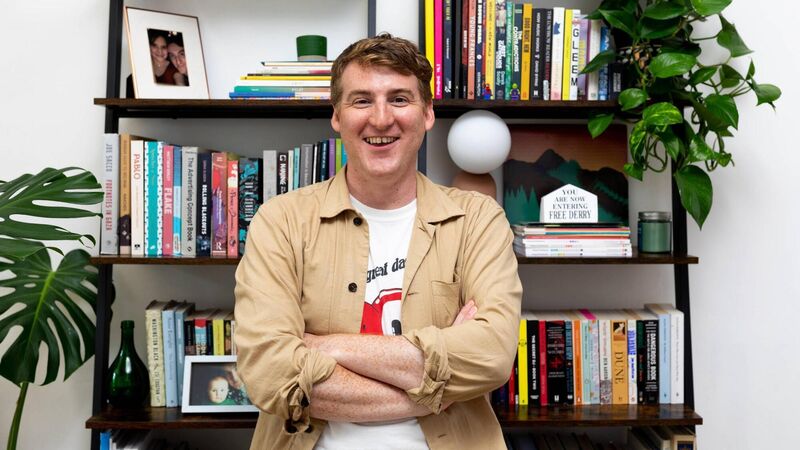Séamas O'Reilly: My new favourite TV show has to be seen to be believed

Séamas O'Reilly. Picture: Orfhlaith Whelan
More than 80% of Earth’s residents now carry HD cameras everywhere they go, on pocket-sized phones that hold a full suite of instant production materials.
TikTok boasts more sophisticated editing tools than those possessed by global film studios 10 or 15 years ago, and it has placed this software in 1.6bn pockets worldwide, for free.
This has had drawbacks for film, of course. Few major directors make contemporary-set films any more, because a world in which everyone has the collected knowledge of mankind in their pocket rather spoils the fun. For documentarians, a different crisis emerges. What good is saying “you have to see this to
believe it” when we see a thousand unbelievable, true-life stories before breakfast? We are all now chroniclers of reality, vastly outpacing the artists for whom this was once their exclusive role.
YouTube alone uploads 30,000 hours of content every hour, much of which would be classed as documentary had it been broadcast on television 10 years ago. Every minute, in every corner of the globe, thousands of hours’ worth of editorially constructed documentary footage is beamed into the cloud, albeit in the form of personal recordings showing lives being lived wherever people live lives.
Which is why HBO’s How To With John Wilson, my favourite TV programme of the year, shouldn’t be as good as it is. In fact, it probably shouldn’t exist at all.
John Wilson is a writer and videographer from New York, who is not to be — and one presumes rarely is — confused with the Garda whistleblower of the same name. His documentary series How To ... is essentially a sequence of video essays which, taken in their most literal sense, are not dissimilar to the sorts of videos you see on TikTok or YouTube every day; hundreds of shots of ordinary people going about their lives, recorded without prompt, artifice or staging.
Each episode purports to instruct you on a particular theme: How To Improve Your Memory; How To Find A Restroom, How To Appreciate Wine; and is addressed to you directly, with judicious use of the second person.
“You spend a lot of time indoors.” “You ask a cat photographer to take your portrait.” “You travel to Arizona to help deliver the organ.” Often the topic is deliberately opaque, and the course of the episode diverges wildly from that title, but without ever betraying its core premise.
How To with John Wilson is a show about nothing that’s a show about everything, constructed with a casual brilliance that consistently drops the jaw. Wilson’s narration strings his footage together, delivering thoughts on each week’s topic with studied amateurism, all throat clearing and halted speech. There is scarcely 30 seconds that goes by without an incredible juxtaposition of sound and image. As in the first episode of the third season, when he bemoans the lack of public restrooms in his native New York, while showing footage of people slowly jogging, an abandoned van covered in droppings, and a long, lingering shot of liquid concrete being poured from a pipe.
Compared to HBO hits like House of the Dragon or Succession, How To ... must not be a very expensive programme to make. There are no actors or studios, no special or practical effects, and very few set-ups or set-pieces. The running costs for some episodes should, in theory, be roughly the same as the cost of pressing record on a camera and letting it run for a day or two. The genius is in Wilson’s curation, the sheer volume of material he’s accumulated, and the impossible skill with which he’s hewed them together to make something greater than the sum of their innumerable parts.
The video collage style is notable not just for its effectiveness, but the care with which each sequence is composed. Sometimes you’re left speechless solely by the time it must have taken to collect all the footage necessary, as when a riff on forgetfulness is intercut with half a dozen shots of people he’s spotted speaking into phones which have their flashlights still on.
These collage sequences form the bread and butter of How To ..., but they are enhanced with vox pops from people on the street, impromptu discussions with experts, and extravagant detours into unrelated corners, as when his unsuccessful search for a public toilet in his neighbourhood leads him to attend house viewings, a party bus, and eventually an RV that takes him for a week-long trip to Burning Man.
In these circumtances, especially, we witness Wilson’s skills in full flight. There is, I’m sure, a precise term for the ability to pull incredible admissions and insights from perfect strangers, the kind that seem like they’ve been ripped, fully-formed from an unproduced Coen Brothers script.
Many have noted Louis Theroux’s skill at coaxing people to say, on film, things you or I would not disclose under torture. Wilson takes this subtle science and turns it into fine art. Consider the show’s first episode, in which a brief encounter with a wrestling fan results in an invitation to said fan’s apartment, where he asks to be filmed while engaging in his part time gig as an independent paedophile hunter. Or his chance meeting with a supermarket merchandiser, who begins their interaction by showing the optimum layout of brands on store shelves, before seguing into his belief in parallel universes and deleted memories. Need I mention the 12-minute sequence in one episode which progresses from him wanting to get in shape, to hiring a cat photographer to take his semi-nude shots, to consulting with a writer of pet-themed mystery novels when said shots are stolen, to attending a 9/11-themed bodybuilding contest.
The show aired its final episode a few weeks ago, and it is one of the finest units of television I’ve watched in some time. I could mention some of what happens — in fact I already have — but I insist you watch it yourself. The finest compliment I can pay this show is the oldest one of all: you just have to see it to believe it.





